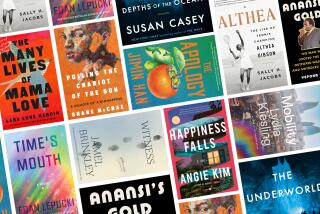A Tame Telling of the Second Coming : CHARLIE PEACE: A Fable, <i> by Paul Pickering,</i> Random House, $20; 297 pages
- Share via
The jacket copy of “Charlie Peace” remarks hopefully that Paul Pickering’s new novel, “which is as blasphemous to Christianity as ‘The Satanic Verses’ is to Islam, promises to outrage a broad segment of the public--and become an instant success de scandale .”
Yes, and pigs might whistle in four-part harmony and play the xylophone with their cloven hooves.
All that might happen, but it probably won’t. In the first place, “Charlie Peace” isn’t very blasphemous. In the second, a broad segment of the public probably isn’t going to see this nice little fable, and in the third place there isn’t very much scandale at all.
“Charlie Peace” takes as its theme the moderately tried and true observation:
“If Jesus Christ was born again today, what would happen? People certainly haven’t improved all that much over 2,000 years. We’d probably crucify Him all over again.” (And, indeed, on the title page, this fable is described as a “cruci-fiction.”)
The audience for this tale is young people between the ages of 12 and 22, who have had orthodox Christianity crammed down their throats in various unpleasant ways during their early youth.
There comes a time in most thinking adolescents’ development when they begin to wonder about Mary Magdalene, for instance, and why Christ befriended her instead of a nice respectable girl.
They wonder about the nature of all those miracles; why the Wedding at Cana came first and why Christ changed water into wine instead of, oh, maybe root beer. They wonder about the loaves and the fishes, and how Lazarus felt, yanked so rudely from the tomb.
And some of them get fed up with all the “hallmark” images of a heavily shampooed Christ. They begin to wonder what He really might have been like.
In this fable, Christ gets to be born again and again and again. Sometimes he walks on water by strolling along a coral reef just under the surface of the sea.
His miracles in ancient times include taking his best friend Pax (the 13th Disciple) for long rides over the desert on his Harley Davidson, and conjuring baby elephants from under St. Peter’s robe. The Christ figure (Charlie Peace’s) miracles in the modern world include (seeming to) turn talcum powder into cocaine.
The scenes here are divided into three main parts: The same ancient Israel we’ve gotten used to from Sunday School, a modern setting in the North of England where Christ and his followers hang out in a tattered Fun Fair, and a mildly inaccurate America in the 1930s, where a disciple tells about his Christ figure who grows up in Kansas taking the “Oath” (sic) of Allegiance, and Carpetbaggers cruise around from the Civil War, and farmers swill whiskey in a state that is still meticulously dry.
One doubts that any of these little slips in the world of “fact” would bother Paul Pickering. He’s writing a fable.
He wants to establish that good and evil exist side by side, that when Jesus cured the sick, that didn’t necessarily mean they wouldn’t die later.
He wants to establish that Jesus was as interested in sex as the next man. (Well at least Pickering proves that he’s as interested in sex as the next man.)
Symbols galore float through this book: Fossil fish hover in the air like Cheshire cats, wounds turn into lillies and vice versa, and a very important Bell, Book and Candle aren’t used in their traditional ways, but to create much of the “magic” inherent in these Christian miracles with which Pickering is so preoccupied.
If you have a kid who’s beginning to sigh audibly in church, to mutter back at the minister under his breath, this is the book to give him (or her).
“Charlie Peace” is so respectable, so literary, so traditional in its dissent that the dissenter in your midst will be apt to drop it all and take up soccer or embroidery for thrills.
There’s not a breath of scandale in this safe little story.
Next: John Wilkes reviews “From Paralysis to Fatigue” by Edward Shorter (The Free Press).
More to Read
Sign up for our Book Club newsletter
Get the latest news, events and more from the Los Angeles Times Book Club, and help us get L.A. reading and talking.
You may occasionally receive promotional content from the Los Angeles Times.









